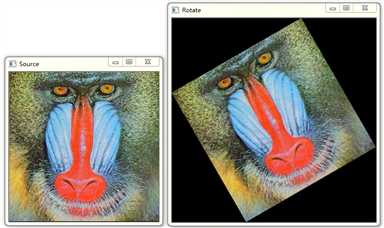标签:
几何变换可以看成图像中物体(或像素)空间位置改变,或者说是像素的移动。
几何运算需要空间变换和灰度级差值两个步骤的算法,像素通过变换映射到新的坐标位置,新的位置可能是在几个像素之间,即不一定为整数坐标。这时就需要灰度级差值将映射的新坐标匹配到输出像素之间。最简单的插值方法是最近邻插值,就是令输出像素的灰度值等于映射最近的位置像素,该方法可能会产生锯齿。这种方法也叫零阶插值,相应比较复杂的还有一阶和高阶插值。
插值算法感觉只要了解就可以了,图像处理中比较需要理解的还是空间变换。
空间变换对应矩阵的仿射变换。一个坐标通过函数变换的新的坐标位置:

所以在程序中我们可以使用一个2*3的数组结构来存储变换矩阵:

以最简单的平移变换为例,平移(b1,b2)坐标可以表示为:

因此,平移变换的变换矩阵及逆矩阵记为:

缩放变换:将图像横坐标放大(或缩小)sx倍,纵坐标放大(或缩小)sy倍,变换矩阵及逆矩阵为:

选择变换:图像绕原点逆时针旋转a角,其变换矩阵及逆矩阵(顺时针选择)为:

基本的放射变换函数:

void cvWarpAffine( const CvArr* src,//输入图像 CvArr* dst, //输出图像 const CvMat* map_matrix, //2*3的变换矩阵 int flags=CV_INTER_LINEAR+CV_WARP_FILL_OUTLIERS, //插值方法的组合 CvScalar fillval=cvScalarAll(0) //用来填充边界外的值 );
另外一个比较类似的函数是cvGetQuadrangleSubPix:

void cvGetQuadrangleSubPix( const CvArr* src, //输入图像 CvArr* dst, // 提取的四边形 const CvMat* map_matrix //2*3的变换矩阵 );
这个函数用以提取输入图像中的四边形,并通过map_matrix变换存储到dst中,与WarpAffine变换意义相同,
即对应每个点的变换:

WarpAffine与 GetQuadrangleSubPix 不同的在于cvWarpAffine 要求输入和输出图像具有同样的数据类型,有更大的资源开销(因此对小图像不太合适)而且输出图像的部分可以保留不变。而 cvGetQuadrangleSubPix 可以精确地从8位图像中提取四边形到浮点数缓存区中,具有比较小的系统开销,而且总是全部改变输出图像的内容。

//逆时针旋转图像degree角度(原尺寸) void rotateImage(IplImage* img, int degree) { IplImage *img_rotate = cvCloneImage(img); cvZero(img_rotate); //旋转中心为图像中心 CvPoint2D32f center; center.x=float (img->width/2.0+0.5); center.y=float (img->height/2.0+0.5); //计算二维旋转的仿射变换矩阵 float m[6]; CvMat M = cvMat( 2, 3, CV_32F, m ); cv2DRotationMatrix( center, degree,1, &M); //变换图像,并用黑色填充其余值 cvWarpAffine(img,img_rotate, &M,CV_INTER_LINEAR+CV_WARP_FILL_OUTLIERS,cvScalarAll(0) ); cvNamedWindow("原图"); cvNamedWindow("旋转后的图像"); cvShowImage("原图",img); cvShowImage("旋转后的图像",img_rotate); }
逆时针旋转30度结果:



//旋转图像内容不变,尺寸相应变大 IplImage* rotateImage1(IplImage* img,int degree){ //逆时针旋转 double angle = degree * CV_PI / 180.; // 弧度 double a = sin(angle), b = cos(angle); int width = img->width; int height = img->height; int width_rotate= int(height * fabs(a) + width * fabs(b)); int height_rotate=int(width * fabs(a) + height * fabs(b)); //旋转数组map // [ m0 m1 m2 ] ===> [ A11 A12 b1 ] // [ m3 m4 m5 ] ===> [ A21 A22 b2 ] float map[6]; CvMat map_matrix = cvMat(2, 3, CV_32F, map); // 旋转中心 CvPoint2D32f center = cvPoint2D32f(width / 2, height / 2); //函数返回一个指向2X3矩阵的指针 //PointF center:源图像的旋转中心 //double angle:源图像旋转的角度,正值表示逆时针旋转(坐标原点假设在图像左上角) //double scale:等向比例因子 //IntPer mapMatrix:用于返回的2X3矩阵 cv2DRotationMatrix(center, degree, 1.0, &map_matrix); map[2] += (width_rotate - width) / 2; map[5] += (height_rotate - height) / 2; IplImage* img_rotate = cvCreateImage(cvSize(width_rotate, height_rotate), 8, 3); //对图像做仿射变换 //输入图像 //输出图像 //2*3的变换矩阵 //插值方法的组合 CV_WARP_FILL_OUTLIERS - 填充所有输出图像的象素。 //如果部分象素落在输入图像的边界外,那么它们的值设定为 fillval. //CV_WARP_INVERSE_MAP - 指定 map_matrix 是输出图像到输入图像的反变换, //用来填充边界外的值 cvWarpAffine( img,img_rotate, &map_matrix, CV_INTER_LINEAR | CV_WARP_FILL_OUTLIERS, cvScalarAll(0)); cvNamedWindow("原图"); cvNamedWindow("旋转后的图像"); cvShowImage("原图",img); cvShowImage("旋转后的图像",img_rotate); return img_rotate; }

//旋转图像内容不变,尺寸相应变大 IplImage* rotateImage2(IplImage* img, int degree) //顺时针旋转 { double angle = degree * CV_PI / 180.; double a = sin(angle), b = cos(angle); int width=img->width, height=img->height; //旋转后的新图尺寸 int width_rotate= int(height * fabs(a) + width * fabs(b)); int height_rotate=int(width * fabs(a) + height * fabs(b)); IplImage* img_rotate = cvCreateImage(cvSize(width_rotate, height_rotate), img->depth, img->nChannels); cvZero(img_rotate); //保证原图可以任意角度旋转的最小尺寸 int tempLength = sqrt((double)width * width + (double)height *height) + 10; //sqrt()开平方根 int tempX = (tempLength + 1) / 2 - width / 2; int tempY = (tempLength + 1) / 2 - height / 2; IplImage* temp = cvCreateImage(cvSize(tempLength, tempLength), img->depth, img->nChannels); cvZero(temp); //将原图复制到临时图像tmp中心 cvSetImageROI(temp, cvRect(tempX, tempY, width, height)); cvCopy(img, temp, NULL); cvResetImageROI(temp); cvNamedWindow("临时图像"); cvShowImage("临时图像",temp); //旋转数组map // [ m0 m1 m2 ] ===> [ A11 A12 b1 ] // [ m3 m4 m5 ] ===> [ A21 A22 b2 ] float m[6]; int w = temp->width; int h = temp->height; m[0] = b; m[1] = a; m[3] = -m[1]; m[4] = m[0]; // 将旋转中心移至图像中间 m[2] = w * 0.5f; m[5] = h * 0.5f; CvMat M = cvMat(2, 3, CV_32F, m); cvGetQuadrangleSubPix(temp, img_rotate, &M); cvReleaseImage(&temp); cvNamedWindow("原图"); cvNamedWindow("旋转后的图像"); cvShowImage("原图",img); cvShowImage("旋转后的图像",img_rotate); return img_rotate; }



//以下代码理论可参考:http://blog.csdn.net/fengbingchun/article/details/17713429 Mat rotateImage3(Mat src){ //仿射变换 Point2f srcTri[3]; Point2f dstTri[3]; Mat rot_mat( 2, 3, CV_32FC1 ); Mat warp_mat( 2, 3, CV_32FC1 ); Mat warp_dst, warp_rotate_dst; warp_dst = Mat::zeros( src.rows, src.cols, src.type() ); // 用3个点确定A仿射变换 srcTri[0] = Point2f( 0,0 ); srcTri[1] = Point2f( src.cols - 1, 0 ); srcTri[2] = Point2f( 0, src.rows - 1 ); dstTri[0] = Point2f( src.cols*0.0, src.rows*0.33 ); dstTri[1] = Point2f( src.cols*0.85, src.rows*0.25 ); dstTri[2] = Point2f( src.cols*0.15, src.rows*0.7 ); warp_mat = getAffineTransform( srcTri, dstTri ); warpAffine( src, warp_dst, warp_mat, warp_dst.size() ); /// 旋转矩阵 Point center = Point( warp_dst.cols/2, warp_dst.rows/2 ); double angle = -50.0; double scale = 0.6; ////获取旋转矩阵 scale为缩放因子(x、y方向保持一致),angle为旋转角度(弧长),centerx,centery为旋转中心 rot_mat = getRotationMatrix2D( center, angle, scale ); // | a b (1-a)*center.x-b*center.y | a=scale*cos(angle) // M= | | // | -b a b*center.x+(1-a)*center.y| b=scale*sin(angle) warpAffine( warp_dst, warp_rotate_dst, rot_mat, warp_dst.size() ); //实现坐标系仿射变换 ////OpenCV 1.0的形式 //IplImage * img=cvLoadImage("baboon.jpg"); //IplImage *img_rotate=cvCloneImage(img); //CvMat M =warp_mat; //cvWarpAffine(img,img_rotate, &M,CV_INTER_LINEAR+CV_WARP_FILL_OUTLIERS,cvScalarAll(0) ); //cvShowImage("Wrap2",img_rotate); namedWindow( "Source", CV_WINDOW_AUTOSIZE ); imshow( "Source", src ); namedWindow( "Wrap", CV_WINDOW_AUTOSIZE ); imshow( "Wrap", warp_dst ); namedWindow("Wrap+Rotate", CV_WINDOW_AUTOSIZE ); imshow( "Wrap+Rotate", warp_rotate_dst ); return warp_dst; }

主函数:

// ImageRotation2.cpp : 定义控制台应用程序的入口点。 // 本文代码参考:http://www.cnblogs.com/slysky/archive/2012/03/21/2410743.html #include "stdafx.h" #include <opencv2/core/core.hpp> //cvGetSize cvCreateImage #include <opencv2/highgui/highgui.hpp> #include <opencv2/opencv.hpp> //cvResize cvInitMatHeader cvGetMinMaxHistValue cvCvtColor #include <opencv2/imgproc/imgproc.hpp> #ifdef _DEBUG #pragma comment(lib, "opencv_core244d") #pragma comment(lib, "opencv_highgui244d") #pragma comment(lib, "opencv_imgproc244d") //cvResize #else #pragma comment(lib, "opencv_core244") #pragma comment(lib, "opencv_highgui244") #pragma comment(lib, "opencv_imgproc244") //cvResize #endif using namespace std; //隐藏控制台窗口 #pragma comment(linker, "/subsystem:\"windows\" /entry:\"mainCRTStartup\"") int main( ) { //读入图像 //Mat src = imread( "./images/baboon.jpg", 1 ); //src = rotateImage3(src); int degree = 30; IplImage *src = cvLoadImage("./images/meng3.jpg",CV_LOAD_IMAGE_UNCHANGED); rotateImage(src, degree); //src = rotateImage1(src, degree); //src = rotateImage2(src, degree); waitKey(0); return 0; }
本文转自:http://blog.csdn.net/xiaowei_cqu/article/details/7616044
标签:
原文地址:http://www.cnblogs.com/tianyalu/p/5698371.html